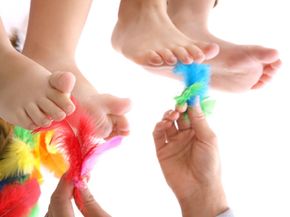Ticklish Spots
Darwin wasn't totally off-base in his hypothesis, but the part about tickling being related to humor missed the mark. He also posited that we're ticklish in places where we aren't usually touched by others. People may be ticklish in spots that commonly produces a tickle reflex to varying degrees -- or not at all. Others may be ticklish in places where most other people aren't.
The soles of the feet and the underarms are two of the most common ticklish places on the body. But the feet's ticklishness fits nicely with Darwin's theory, since the soles of the feet are accustomed to diffuse pressure from the rest of the body when we're standing or walking [source: Mintz]. You probably won't get much of a response if you try to tickle the sole of another person's foot by pushing the open palm of your hand against it. What's more, the soles of the feet have a high concentration of Meissner's corpuscles, highly sensitive nerve receptors located close to the skin's surface [source: BBC]. These nerve endings make the feet extra ticklish.
Advertisement
As we saw on the last page, the most common ticklish spots are also often those most vulnerable to attack, at least around the upper body. Your underarm contains the axillary vein and artery, and it also allows unimpeded access to your heart, since the rib cage no longer provides protection to the chest cavity at the underarm. The same goes for another ticklish spot, the neck. Without protective bones in either place, it would make sense that we would reflexively react to another person touching those areas. The neck contains all kinds of vital material. It houses two of the most important arteries in the human body -- the carotids, which supply the brain with blood. The trachea, which brings air into the lungs, is also located in the front of the neck.
Ultimately, we can't say for certain why people laugh when they're tickled, just as we're not entirely certain why people are ticklish in the first place. As long as there are older siblings and parents around, though, one would think that this unfunded and informal experimentation will continue unabated.
For more on tickling and related topics, please see the links below.
Related HowStuffWorks Articles
Sources
- BBC. "Nervous system layer." Accessed June 3, 2009. http://www.bbc.co.uk/science/humanbody/body/factfiles/touch/touch.shtml
- Blackmore, Sarah-Jayne. "Why can't a person tickle himself?" Scientific American. August 4, 2003.http://www.scientificamerican.com/article.cfm?id=why-cant-a-person-tickle
- Mintz, Thomas MD. "Tickle - the itch that moves." Psychosomatic Medicine. 1967. http://www.psychosomaticmedicine.org/cgi/reprint/29/6/606.pdf
- Provine, Robert R. "Laughing, tickling, and the evolution of speech and self." Current Directions in Psychological Science. 2004. http://www.chsbs.cmich.edu/hajime_otani/Classes/100/Extra1.pdf
- Queen's University. "The science of tickling." January 19, 2006. http://www.physorg.com/news10056.html
- Tierney, John. "What's so funny? Well, maybe nothing." New York Times. March 13, 2007.http://www.nytimes.com/2007/03/13/science/13tier.html?pagewanted=1&_r=1
- Uhlig, Robert and Derbyshire, David. "Proof that you can't fool your brain with a tickle." Telegraph. September 11, 2000. http://www.telegraph.co.uk/news/uknews/1354950/Proof-that-you-cant-fool-your-brain-with-a-tickle.html
- Yoon, Carol Kaesuk. "Anatomy of a tickle is serious business at research lab." New York Times. June 3, 1997.http://www.nytimes.com/1997/06/03/science/anatomy-of-a-tickle-is-serious-business-at-the-research-lab.html?sec=&spon=&pagewanted=all
